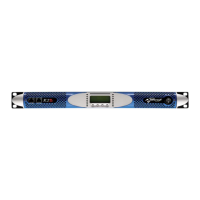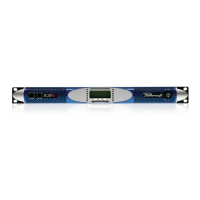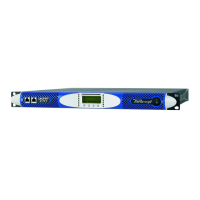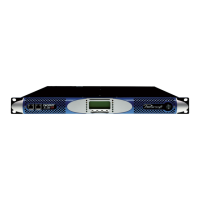RMS
2
P
RMS equiv
=
8
where P
RMS equiv
is the equivalent power on the 8 Ω speaker and
V
RMS
is the RMS voltage value calculated at step 1. In this example
this is 250W. This is the threshold power to set in the limiter.
The time constants for the Power vs V @ 8 Ohm limiter can be set
in the same way as for the TruePower limiter.
Power vs I @ 8 Ω
This limiter’s behavior is similar to the case Power vs V @ 8 Ω with
the difference that all calculations are based on the current (and
not voltage) measured at the output. In this case the formula to
derive the RMS power from the RMS current is:
I
RMS
2
P
RMS
=
R
where P
RMS
is the RMS power and I
RMS
is the RMS current. This
limiter is particularly useful in situations where the parameter to
be controlled is the output current (e.g. for tweeters). It is also
useful for special applications such as large coil speakers with
current controls. When determining this limiter’s parameters, it is
necessary to take into account the number of speakers connected
in parallel to the amplier.
Power limiter settings
Power Limiter parameters that can be edited by the user are:
▶
Mode: allows to determine the power limiter
1. OFF/ON turns the limiter on or off
2. TruePower: sets the limiter mode to TruePower
3. Power vs V @ 8 Ohm
4. Power vs I @ 8 Ohm
▶
Soft knee: (ON/OFF)
▶
Thresh.(W): threshold output power level expressed in
Watts at which the gain begins to be reduced
▶
Attack(ms): the time it takes for the limiter to start reducing
the amplier gain once the output power has exceeded the
threshold value
▶
Release (ms): the time constant after which the gain is restored
its nominal value once the output power has returned below
the threshold
When editing the power threshold value, the display shows the
gain reduction (GR) in dBs enforced by the combined effect of
the peak and power limiters. This information, together with the
average power truly delivered to the load (Pavg), is displayed in
real time to allow monitoring of the limiting actions as they are
performed.
8.2.2.7 Damping Control
WARNING: when damping control is enabled, a lowpass lter
cutting around 400 Hz is automatically inserted into the amplier
chain. This feature is intended to be used only for subwoofer
applications.
This unique and patented feature allows to add a “virtual” series
resistor to the amplier output. This is done to obtain the desired
damping factor with any cabling used. For this end, the virtual
series resistor can also have a negative value to compensate cabling
resistance. For example, using a 10 meter cable to powering the
subwoofer means adding a series parasitic resistance of about 0.3
Ohms. By enabling the damping control, a virtual negative series
resistance can be added to compensate the cable resistance.
Typical cabling resistance:
AWG section area Length (m) Resistance (�)
16 2 x 1.5 mm
2
5 0.13
16 2 x 1.5 mm
2
10 0.26
16 2 x 1.5 mm
2
20 0.52
14 2 x 1.5 mm
2
5 0.08
14 2 x 1.5 mm
2
10 0.16
14 2 x 1.5 mm
2
20 0.32
12 2 x 4 mm
2
5 0.05
12 2 x 4 mm
2
10 0.10
12 2 x 4 mm
2
20 0.20
Another advantage offered by the damping control feature is that
in adding the series equivalent output resistance to the amplier
chain, the voice coil resistance increase due to heating can be
taken into account. This allows to obtain a correctly damped bass
response at average working condition, where the voice coils is
subject to heating due to the passage of current. For example,
if the subwoofers are going to work at close to full power, an
additional negative resistance of 1 to 2 Ohms should be added
to compensate the high resistance generated by the heated voice
coils to obtain a correctly damped response. On the other hand, if
the same subwoofers are working at low power, a smaller negative
resistance should be added: in this case the cooler voice coil
presents a smaller series resistance to be compensated. Leaving
too high an equivalent series resistance results in an overdamped
system.
Typical resistance increase due to voice coil heating. Notice the
exceptionally high value (3.8 Ohm) when the driver reaches it
thermal limit:

